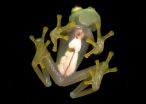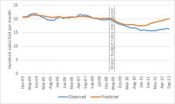(Press-News.org) WASHINGTON, Feb. 20, 2014 — Their research may lead to a new generation of renewable fuels, medical devices and safer home products. The American Chemical Society (ACS) is continuing its celebration of Black History Month with a new video featuring several African-American chemists and chemical engineers doing cutting edge research today. The video is available at http://youtu.be/v0PmKbJNAQI.
The video, produced with the National Organization for the Professional Advancement of Black Chemists and Chemical Engineers (NOBCChE), highlights the efforts of Kristala Prather, Ph.D., associate professor at the Massachusetts Institute of Technology, to reverse-engineer bacteria into biofuel factories. The video also features research on flexible polymers for smartphones and medical devices, as well as a range of research being done at the National Institute of Standards and Technology.
The previous video in the series, "Five Black Chemists Who Changed the World" is available here.
INFORMATION:
The American Chemical Society is a nonprofit organization chartered by the U.S. Congress. With more than 161,000 members, ACS is the world's largest scientific society and a global leader in providing access to chemistry-related research through its multiple databases, peer-reviewed journals and scientific conferences. Its main offices are in Washington, D.C., and Columbus, Ohio.
To automatically receive news releases from the American Chemical Society, contact newsroom@acs.org.
Follow us: Twitter Facebook YouTube
Spotlighting black chemists and chemical engineers (video)
2014-02-20
ELSE PRESS RELEASES FROM THIS DATE:
High cost of fruits, vegetables linked to higher body fat in young children
2014-02-20
Washington, D.C.--High prices for fresh fruits and vegetables are associated with higher Body Mass Index (BMI) in young children in low- and middle-income households, according to American University researchers in the journal Pediatrics.
"There is a small, but significant, association between the prices of fruit and vegetables and higher child BMI," said Taryn Morrissey, the study's lead author and assistant professor of public administration and policy at AU's School of Public Affairs (SPA).
Morrissey said that when the prices of fruits and vegetables go up, families ...
Cell behavior in low oxygen conditions mapped
2014-02-20
LIVERPOOL, UK – 17 February 2014: Research at the University of Liverpool has explained how cells behave when placed in a low oxygen environment, a development that could have implications for cancer patients and other serious illnesses.
The research opens up the possibility of controlling the signals that keep cells alive, preventing the damages caused by ischemia – a restriction of blood supply to tissues. It could also work to help destroy cancer cells.
When the body is deprived of adequate oxygen supply it is known as hypoxia and can cause the death of cells. This ...
Astronomers find solar storms behave like supernovae
2014-02-20
Researchers at UCL have studied the behaviour of the Sun's coronal mass ejections, explaining for the first time the details of how these huge eruptions behave as they fall back onto the Sun's surface. In the process, they have discovered that coronal mass ejections have a surprising twin in the depths of space: the tendrils of gas in the Crab Nebula, which lie 6500 light-years away and are millions of times larger.
On 7 June 2011, the biggest ejection of material ever observed erupted from the surface of the Sun. Over the days that followed, the plasma belched out ...
High potency statins linked to better outcome following a heart attack
2014-02-20
A study looking at the data of thousands of patients who suffered heart attacks has suggested treatment with high-potency statins offers a significantly improved chance of survival compared to those taking normal statins.
The study, led by the University of Dundee, also found a combination of statins and the drug ezetimibe showed no improved survival rate, although researchers caution this finding needs further testing.
"There is presently a lot of interest in ezetimibe as a potential treatment for heart patients," said Professor Chim Lang, from the Division of Cardiovascular ...
Mistaken point, Sanctuary of Zeus, catastrophic outburst floods, shocked sand grains
2014-02-20
Boulder, Colo., USA – GSA Bulletin postings for February cover the sculpting of Earth's surface as seen in the Pyrenees; facies architecture in Washington State, USA; atmospheric circulation recorded in the Permian Maroon Formation; preglacial fluvial gorges and valleys; banded iron formations; paleosols in Wapadsberg Pass, South Africa; Ediacaran fossils from Mistaken Point, Newfoundland; geologic forensics and sedimentary fingerprints; catastrophic outburst floods recorded in the Tibetan Plateau; the Sudbury impact structure, Canada; and observations at the Sanctuary ...
Aging men: More uplifts, fewer hassles until the age of 65-70
2014-02-20
CORVALLIS, Ore. – A new study of how men approach their golden years found that how happy individuals are remains relatively stable for some 80 percent of the population, but perceptions of unhappiness – or dealing with "hassles" – tends to get worse once you are about 65-70 years old.
The reasons vary, researchers say, but may be because of health issues, cognitive decline or the loss of a spouse or friends.
"In general, life gets better as you age in the sense that older adults on average have fewer hassles – and respond to them better – than younger adults," said ...
Rocks around the clock: Asteroids pound tiny star
2014-02-20
Scientists using the Australian Commonwealth Scientific and Industrial Research Organisation's (CSIRO) Parkes telescope and another telescope in South Africa have found evidence that a tiny star called PSR J0738-4042 is being pounded by asteroids — large lumps of rock from space.
"One of these rocks seems to have had a mass of about a billion tonnes," CSIRO astronomer and member of the research team Dr Ryan Shannon said.
PSR J0738-4042 lies 37,000 light-years from Earth in the constellation of Puppis.
The environment around this star is especially harsh, full of radiation ...
Peru's Manu National Park sets new biodiversity record
2014-02-20
Peru's treasured Manu National Park is the world's top biodiversity hotspot for reptiles and amphibians, according to a new survey published last week by biologists from the University of California, Berkeley, Southern Illinois University in Carbondale (SIU-Carbondale) and Illinois Wesleyan University.
The park, which encompasses lowland Amazonian rain forest, high-altitude cloud forest and Andean grassland east of Cuzco, is well known for its huge variety of bird life, which attracts ecotourists from around the globe. More than 1,000 species of birds, about 10 percent ...
An innovative approach to promote water use efficiency
2014-02-20
RIVERSIDE, Calif. — Increasing block-rate water budgets are an innovative type of escalating tiered price structure in which the consumption block sizes are based on household characteristics, environmental conditions, and a judgment by the water utility with regard to what constitutes "efficient" water use given those characteristics and conditions.
In these water budgets, prices are set relatively low for the most essential uses of water but then increase with usage. The price structure more accurately reflects the cost of supplying water and thus sends a more appropriate ...
A new laser for a faster Internet
2014-02-20
A new laser developed by a research group at Caltech holds the potential to increase by orders of magnitude the rate of data transmission in the optical-fiber network—the backbone of the Internet.
The study was published the week of February 10-14 in the online edition of the Proceedings of the National Academy of Sciences. The work is the result of a five-year effort by researchers in the laboratory of Amnon Yariv, Martin and Eileen Summerfield Professor of Applied Physics and professor of electrical engineering; the project was led by postdoctoral scholar Christos Santis ...



